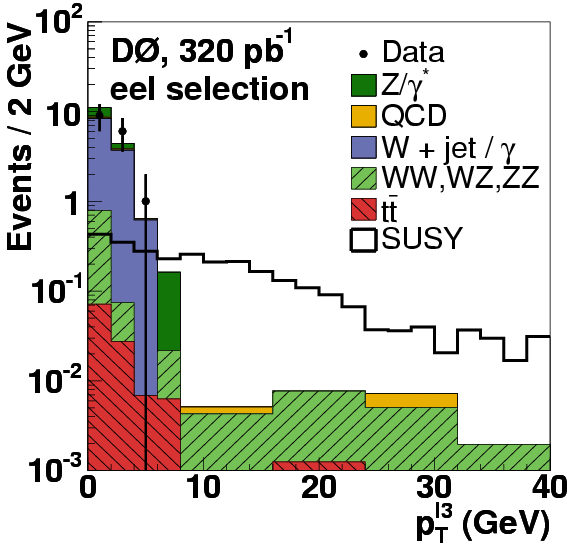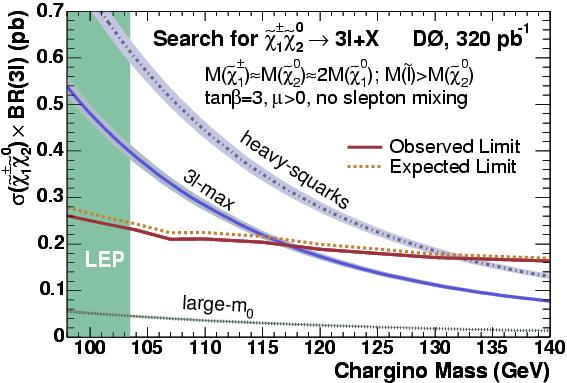

An important goal of particle physics is to describe the elementary
constituents of matter, and the forces which govern them, with a simple unified
theory.
Supersymmetry,
often whimsically called SUSY, is a promising theory that may offer this
unification.
SUSY predicts a new partner for each known particle with similar properties but different spin. Scalar selectrons and smuons would be the partners of the fermionic electrons and muons. Fermionic neutralinos and charginos would be partners to the W and Z bosons, the photon and the Higgs bosons. In SUSY models that conserve R-parity, the lightest SUSY particle (LSP) is stable and a promising candidate for the dark matter, which according to astrophysical measurements, corresponds to one quarter of the mass and energy in the universe.
SUSY particles can be produced in pairs in proton-antiproton collisions at the Tevatron if they are not too heavy. The production of a neutralino with a chargino can be observed by their decay into three electrons or muons and the invisible lightest SUSY particle. Because of conservation of energy and momentum, the particles that are produced in a collision are expected to be balanced in the transverse plane of the detector. Large missing energy in a certain direction is an indication for an invisible particle like the LSP.
The production and decay rate depends on the masses of the SUSY particles
which are predicted by a SUSY model. The production rate of charginos and
neutralinos decreases with increasing chargino and neutralino mass. If the
sleptons are light, the decay rate into leptons is large. If squarks are light,
the production rate of charginos and neutralinos decreases because of destructive
interference. Production rates for a particular process are expressed as an
interacting area, the "cross section", which is measured in units of barn with
1 barn (b) = 10-28 m2.
D0 has used Tevatron Run II data to search for for events containing charginos and neutralinos . Four analyses search for SUSY in final states with:
Possible SUSY events have to be separated from the large amount of so called "background" events, which may look like SUSY at a first glance. The most important backgrounds are Z bosons, the production of W bosons together with jets, events with several jets and the associated production of a W and a Z boson or of two W bosons. In order to separate SUSY candidates from background, a couple of quantities have been analysed that show a different distribution in SUSY events and background events. The following figures show the distribution of four of these quantities for data (black dots), the predicted background (coloured histograms) and the expected SUSY signal (black line):




After the complete selection and after combining the results of the four analyses, three candidates are selected in the Tevatron data, which agrees with the expected number of background events. SUSY models which predict a sufficiently large number of SUSY events above this background are therefore excluded by this analysis. The results can be expressed as an upper limit on the production rate for neutralino-chargino pairs which decay into leptons and LSPs.
The left plot shows the upper limits on the production rate for neutralino-chargino pairs which decay into leptons as a function of the chargino mass. Production cross sections larger than 0.2 pico barn are excluded by the D0 analysis. The upper limits are compared with three theoretical predictions, all of which assume that the SUSY partners of all charged leptons have the same mass.
The right plot shows the upper limits on the production rate as a function of the mass difference between the second neutralino and the slepton. As long as the slepton is larger than the neutralino (right side of the plot) the upper limit is stable at 0.2 picobarn. If the slepton is considerably lighter than the neutralino the upper limit is again below 0.5 picobarn and decreases with the slepton mass. In between the two regions, where the slepton is only slightly lighter than the neutralino, the analyses that search for three leptons are not very sensitive to SUSY because one of the leptons has a very low energy.


D0 will continue to search for evidence of SUSY in the new data coming in, and expects to be able to probe new SUSY territory up to chargino masses of 200 GeV.
If you have any questions about this analysis, please contact the primary authors M.Binder, U.Blumenschein, V.Buescher, M.Hohlfeld and A.Yurkewicz